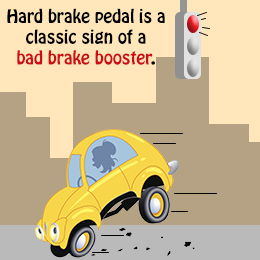
A Common Sight
Most of the modern cars today come with a power booster as they also come with disc brakes, at least for the front wheels. These brakes are not self-energizing like the drum brakes and hence need a brake booster.
The brake boosters, also known as vacuum servos, serve the function of helping the driver when applying brakes in a car. These are, thus, able to reduce the efforts on the driver’s part when bringing the car to a halt or slowing it down. The vacuum servos play an important role in the performance as well as safety of the car. The servos were invented by Albert Dewandre, an engineer at Liege, Belgium, in the year 1927.
The main aim of this device is to reduce the pressure that a driver needs to apply on the brake pedals. This was to facilitate and improve the ease of pushing the brake pedal. The device also reduces the distance that a car travels before coming to a halt, after a driver hits the brake pedals.
The technical name of the vacuum servo is ‘vacuum-actuated servo motors’. These make use of the vacuum or a vacuum sensor to control the electrically-operated servo. A ‘servo’ is an automatic device that uses negative feedback to regulate the operation and functioning of its mechanism.
Bad Brake Booster Symptoms
The signs of a bad brake booster that show up in a car are as follows:
The car takes longer to stop: As a result of the failure of its brake booster, a car will take longer time than usual to come to a complete halt after the brakes are applied. This distance will be more than the distance it would travel with its power booster intact.
Hard brake pedals: Since the main function of a brake booster is to assist the driver in the application of brakes, when the brake booster goes bad, the ease in application of brakes is diminished. The brake pedals become hard and need increased effort to push them down.
How to Diagnose a Bad Brake Booster?
A bad brake booster can be diagnosed in the ways given below.
Way 1
- Keep running the engine for sometime before switching it off.
- After this, press down on the pedal a few times.
If the depth at which the brake pedals can be pushed down decreases after every push, and it becomes difficult to push them any further; then the system is just fine. If not, then it is an indicator of a leak in the brake booster.
Way 2
- Press the brake pedal a few times when the ignition is switched off.
- Keep pushing down on the break pedal when turning on the ignition and allow the engine to run idly.
During this process, the first step is done to clear out any residual vacuum that may be present in the system. After the completion of the second step, the brake pedal will drop a little which indicates proper functioning of the system.
Way 3
- Turn on the ignition.
- Press down lightly on the brake pedal.
If the brake pedal is able to maintain its position and not go low, then it is a sign of an airtight brake booster which means that the brake booster is in a good shape.
It is not safe to drive a vehicle with a bad brake booster. In this case, it may not be possible to hit the brakes in time as it becomes difficult to pump down on them. Even if one gets to them in time, the vehicle will travel a longer distance before coming to a halt, which increases the possibility of a mishap.